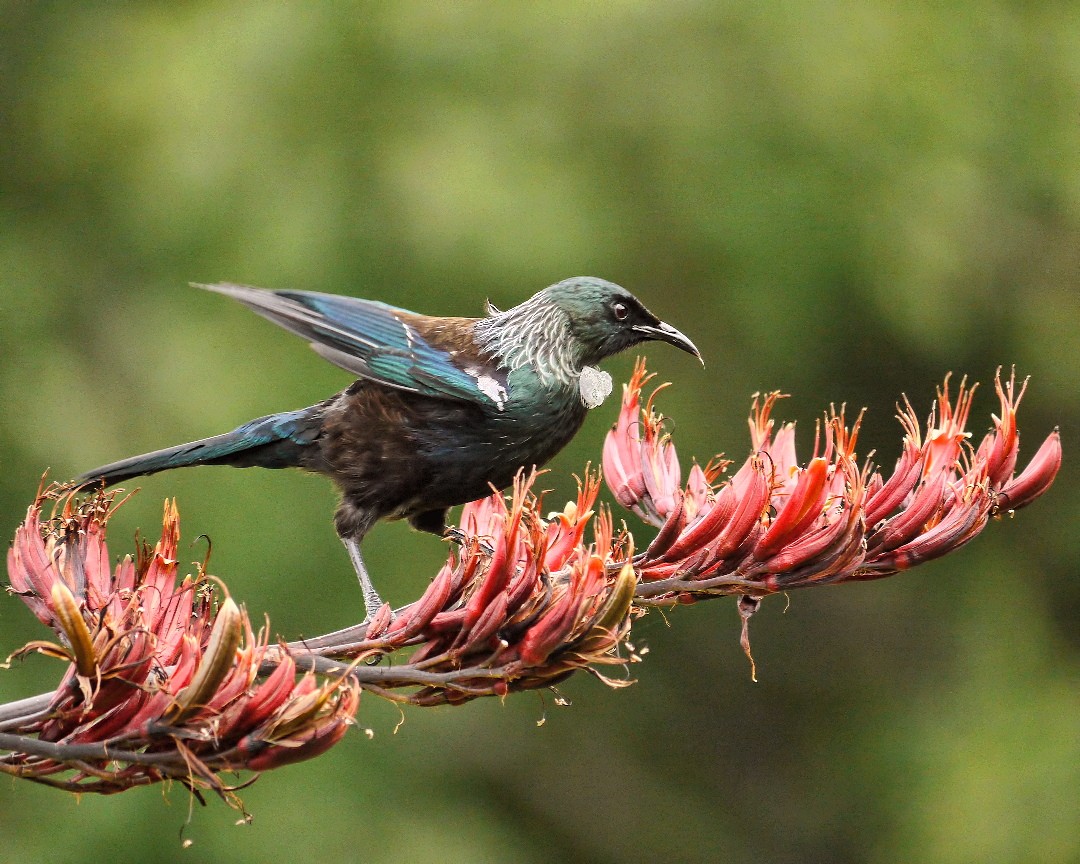Tui
A species of Tui Scientific name : Prosthemadera novaeseelandiae Genus : Tui
Tui, A species of Tui
Botanical name: Prosthemadera novaeseelandiae
Genus: Tui
Content
Description People often ask General Info
Description
The tui is a large honeyeater, 27 to 32 cm (11–13 in) in length. The Chatham Islands subspecies is larger on average than the nominate subspecies, and heavier. Males tend to be heavier than females. Nominate males weigh between 65–150 g (2.3–5.3 oz), and females 58–105 g (2.0–3.7 oz). Males of the Chatham subspecies are 89–240 g (3.1–8.5 oz) and females 89–170 g (3.1–6.0 oz). At first glance the bird appears completely black except for a small tuft of white feathers at its neck and a small white wing patch, causing it to resemble a parson in clerical attire. On closer inspection (see image) it can be seen that tui have brown feathers on the back and flanks, a multicoloured iridescent sheen that varies with the angle from which the light strikes them, and a dusting of small, white-shafted feathers on the back and sides of the neck that produce a lacy collar. 
Size
32 cm
Nest Placement
Tree
Feeding Habits
Tui primarily feast on nectar, supplementing their diet with fruit, insects, pollen, and seeds. They exhibit unique drunken behavior when consuming fermented flax nectar. As major pollinators, their beak shape coevolves with certain flora's flower structure for mutualistic benefits.
Habitat
Tui's habitat spectrum spans broadleaf forests at low elevations, particularly rich in podocarp-broadleaf emergents, including mixed beech and tall kanuka forests with dense undergrowth. Across geographical regions, tui resides in forests, coastal shrublands, manuka scrub, and occasionally in rainforests, adapting to urban parks, gardens and orchards, especially in northern urban areas. Tui can inhabit patches of native forest and areas with exotic flora like privet and eucalyptus. While mostly settled at lower altitudes, sightings extend up to nearly 1500 meters.
Dite type
Nectivorous
People often ask
General Info
Feeding Habits
Bird food type
Behavior
Male tui can be extremely aggressive, chasing all other birds (large and small) from their territory with loud flapping and sounds akin to rude human speech. This is especially true of other tui when possession of a favoured feeding tree is impinged. Birds will often erect their body feathers in order to appear larger in an attempt to intimidate a rival. They have even been known to mob harriers and magpies. The powered flight of tui is quite loud as they have developed short wide wings, giving excellent maneuverability in the dense forest they prefer, but requiring rapid flapping. They can be seen to perform a mating display of rising at speed in a vertical climb in clear air, before stalling and dropping into a powered dive, then repeating. Much of this behaviour is more notable during the breeding season of early spring—September and October. Females alone build nests of twigs, grasses and mosses. 
Distribution Area
Tui are found through much of New Zealand, particularly the North Island, the west and south coasts of the South Island, Stewart Island/Rakiura and the Chatham Islands—where an endangered sub-species particular to these islands exists. Other populations live on Raoul Island in the Kermadecs, and in the Auckland Islands (where, with the New Zealand bellbird, it is the most southerly species of honeyeater). Populations have declined considerably since European settlement, mainly as a result of widespread habitat destruction and predation by mammalian invasive species. Nonetheless, the species is considered secure and has made recoveries in some areas, particularly after removal of livestock has allowed vegetation to recover. Predation by introduced species remains a threat, particularly brushtail possums (which eat eggs and chicks), cats, stoats, the common myna (which competes with tui for food and sometimes takes eggs), blackbirds, and rats. Tui prefer broadleaf forests at low altitudes, although have been recorded up to 1500 metres. It will tolerate quite small remnant patches, regrowth, exotic plantations and well-vegetated suburbs. They are one of the most common birds found in urban Wellington. They are usually seen singly, in pairs, or in small family groups, but will congregate in large numbers at suitable food sources, often in company with silvereyes, bellbirds, or kererū (New Zealand wood pigeon) in any combination. Generally, when interspecific competition for the same food resources among New Zealand's two species of honeyeater occurs, there is a hierarchy with the tui at the top and bellbirds subordinate. The latter are thus frequently chased off by tui at a food source such as a flowering flax plant. 
Species Status
Not globally threatened.
